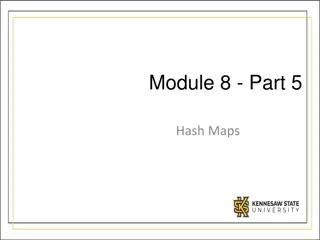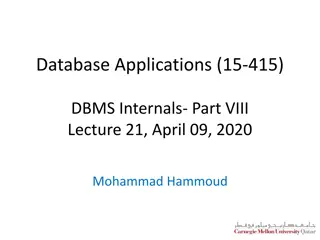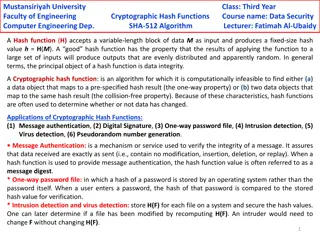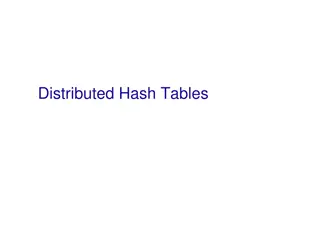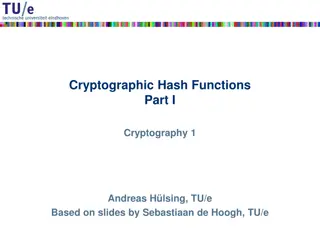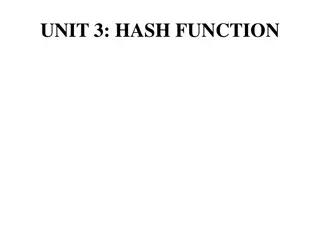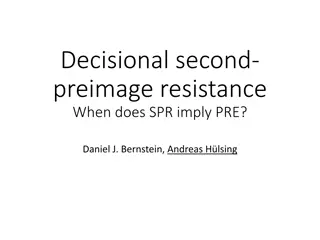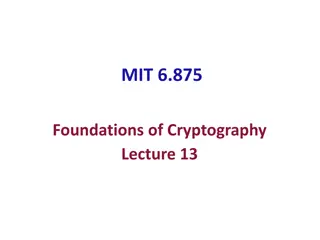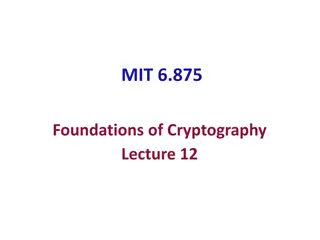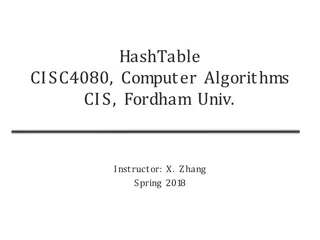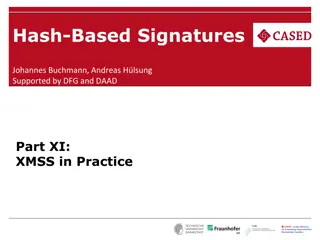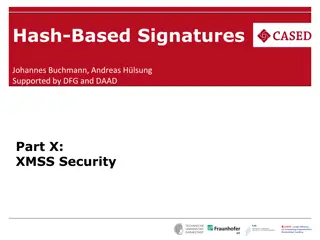
Hash Tables and Functions in Computer Science
Learn about hash tables, key-value pairs, hash functions, and table size considerations in computer science. Discover how to distribute keys evenly, prevent collisions, and select appropriate table sizes and hash functions for efficient data storage and retrieval.
Download Presentation

Please find below an Image/Link to download the presentation.
The content on the website is provided AS IS for your information and personal use only. It may not be sold, licensed, or shared on other websites without obtaining consent from the author. If you encounter any issues during the download, it is possible that the publisher has removed the file from their server.
You are allowed to download the files provided on this website for personal or commercial use, subject to the condition that they are used lawfully. All files are the property of their respective owners.
The content on the website is provided AS IS for your information and personal use only. It may not be sold, licensed, or shared on other websites without obtaining consent from the author.
E N D
Presentation Transcript
1 CSCI 104 Hash Tables & Functions Mark Redekopp David Kempe Sandra Batista Aaron Cote
2 Hash Tables A hash table is an array that stores key,value pairs Usually smaller than the size of possible set of keys, |S| USC ID's = 1010options But larger than the expected number of keys to be entered (defined as n) The table is coupled with a function, h(k), that maps keys to an integer in the range [0..tableSize-1] (i.e. [0 to m-1]) What are the considerations How big should the table be? How to select a hash function? What if two keys map to the same array location? (i.e. h(k1) == h(k2) ) Known as a collision key key, value 0 1 2 3 4 h(k) tableSize-2 tableSize-1 m = tableSize n = # of keys entered
3 Table Size key How big should our table be? Example 1: We have 1000 employees with 3 digit IDs and want to store record for each What is |S|? Expected n? Solution 1: Keep array a[1000]. Let key be ID and location, so a[ID] holds employee record (no collisions) Example 2: Using 5 letter ('a'-'z') nicknames for each student in a class. |S| = 265 for classes of around n=100 students Pick a hash table of some size much smaller (how many students do we have at any particular time) key, value 0 1 2 3 4 h(k) tableSize-2 tableSize-1 m = tableSize n = # of keys entered
4 General Table Size Guidelines key key, value The table size should be bigger than the amount of expected entries (m > n) Don't pick a table size that is smaller than your expected number of entries But anything smaller than the size of all possible keys admits the chance that two keys map to the same location in the table (a.k.a. COLLISION) You will see that tableSize should usually be a prime number 0 1 2 3 4 h(k) tableSize-2 tableSize-1 m = tableSize n = # of keys entered
5 Hash Functions First Look Challenge: Distribute keys to locations in hash table such that Easy to compute and retrieve values given key Keys evenly spread throughout the table Distribution is consistent/repeatable for retrieval If necessary key data type is converted to integer before hash is applied Akin to the operator<() needed to use a data type as a key for the C++ map Example: Strings Use ASCII codes for each character and add them or group them "hello" => 'h' = 104, 'e'=101, 'l' = 108, 'l' = 108, 'o' = 111 = 532 Hash function is then applied to the integer value 532 such that it maps to a value between 0 to M-1 where M is the table size
6 Possible Hash Functions Define n = # of entries stored, m = Table Size, k is non-negative integer key h(k) = 0 ? h(k) = k mod m ? h(k) = rand() mod m ? Rules of thumb The hash function should examine the entire search key, not just a few digits or a portion of the key When modulo hashing is used, the base should be prime
7 Hash Function Goals A "perfect hash function" should map each of the n keys to a unique location in the table Recall that we will size our table to be larger than the expected number of keys i.e. n < m Perfect hash functions are not practically attainable A "good" hash function or Universal Hash Function Is easy and fast to compute Scatters data uniformly throughout the hash table P( h(k) = x ) = 1/m (i.e. pseudorandom)
8 Universal Hash Example Suppose we want a universal hash for words in English language First, we select a prime table size, m For any word w, translate it into a base-m number (using the base-conversion algorithm). For clarity, we are ignoring this step in the following example. The length of the longest valid key has length z Choose a random key word, K, of length z, K = k1 k2 kz The random key is created once when the hash table is created and kept Example: say z=35 (longest word in English is 35 characters). Pick 35 random characters: uebghakdjthzndpwjsqisndaoclcdiwevza Hash function: ? = ?=1 If w = "hello" then h(w) = (h*u + e*e + l*b + l*g + o*h) mod m Plug in ASCII values for each letter being multiplied above Notice if w = "olleh" we will get a very different h(w) ???(?)?? ?? ??? ?
9 Resolving Collisions Collisions occur when two keys, k1 and k2, are not equal, but h(k1) = h(k2). Collisions are inevitable if the number of entries, n, is greater than table size, m (by pigeonhole principle) and are likely even before (by the birthday paradox) Methods Closed Addressing (e.g. buckets or chaining) Open addressing (aka probing) Linear Probing Quadratic Probing Double-hashing
10 Buckets/Chaining k,v Bucket 0 Simply allow collisions to all occupy the location they hash to by making each entry in the table an ARRAY (bucket) or LINKED LIST (chain) of items/entries Close Addressing => You will live in the location you hash to (it's just that there may be many places at that location) Buckets How big should you make each array? Too much wasted space Chaining Each entry is a linked list 1 2 3 4 tableSize-1 Array of Linked Lists key, value 0 1 2 3 4 tableSize-1
11 Hashing Efficiency Loading factor, , defined as: (n=number of items in the table) / m=tableSize => = n / m Really it is just the fraction of locations currently occupied For chaining, , can be greater than 1 This is because n > m What is the average length of a chain in the table (e.g. 10 total items in a hash table with table size of 5)? Best to keep the loading factor, , below 1 Resize and rehash contents if load factor too large (using new hash function)
12 Hash Table Analysis Assume a universal hash function, and =1 When finding the item I m looking for, how many other items, on average, will be in the same bucket? (m-1)/m (Linearity of Expectation!) On average, every item has 1 roommate . Note that this is different than asking what the average bucket size is.
13 Open Addressing Open addressing means an item with key, k, may not be located at h(k) If location 2 is occupied and a new item hashes to location 2, we need to find another location to store it. Let i be number of failed inserts Linear Probing h(k,i) = (h(k)+i) mod m Example: If h(k) occupied (i.e. collision) then check h(k)+1, h(k)+2, h(k)+3, Quadratic Probing h(k,i) = (h(k)+i^2) mod m If h(k) occupied, then check h(k)+12, h(k)+22, h(k)+32, key key, value k, v 0 1 2 3 4 h(k) k, v k, v tableSize-2 tableSize-1 k,v
14 Linear Probing Issues If certain data patterns lead to many collisions, linear probing leads to clusters of occupied areas in the table called primary clustering How would quadratic probing help fight primary clustering? Quadratic probing tends to spread out data across the table by taking larger and larger steps until it finds an empty location key, value occupied 0 1 2 3 4 occupied occupied Linear Probing tableSize-2 tableSize-1 occupied key, value occupied 0 1 2 3 4 5 occupied occupied Quadratic Probing 6 7 occupied
15 Find & Removal Considerations Given linear or quadratic clustering how would you find a given key, value pair First hash it If it is not at h(k), then move on to the next items in the linear or quadratic sequence of locations until you find it or an empty location or search the whole table What if items get removed Now the find algorithm might terminate too early Mark a location as "removed"=unoccupied but part of a cluster key, value occupied 0 1 2 3 4 occupied occupied Linear Probing tableSize-2 tableSize-1 occupied key, value occupied 0 1 2 3 4 5 occupied occupied Quadratic Probing 6 7 occupied
16 Practice Use the hash function h(k)=k%10 to find the contents of a hash table (m=10) after inserting keys 1, 11, 2, 21, 12, 31, 41 using linear probing 0 1 2 3 4 5 6 7 8 9 Use the hash function h(k)=k%9 to find the contents of a hash table (m=9) after inserting keys 36, 27, 18, 9, 0 using quadratic probing 0 1 2 3 4 5 6 7 8
17 Practice If your hash table size isn t prime, bad things can happen! Use the hash function h(k)=k%7 to find the contents of a hash table (m=10) after inserting keys 14, 8, 21, 2, 7 using quadratic probing 0 1 2 3 4 5 6 If your loading factor rises above 0.5, bad things can happen! Quadratic probing only works well for prime table sizes, and keeping the load factor < 0.5
18 Quadratic Probing Number Theory If your hash table has a prime size m, the first m/2 probes are guaranteed to go to distinct locations. (h(k)+i2) % m = (h(k)+j2) % m i2 % m = j2 % m (i2 - j2) % m = 0 (i+j)*(i-j) % m = 0 i,j m/2, and i j, so m < i-j, and i+j < m Since m is prime, you can t divide m over (i+j) and (i-j)
19 Double Hashing Define h1(k) to map keys to a table location But also define h2(k) to produce a linear probing step size First look at h1(k) Then if it is occupied, look at h1(k) + h2(k) Then if it is occupied, look at h1(k) + 2*h2(k) Then if it is occupied, look at h1(k) + 3*h2(k) TableSize=13, h1(k) = k mod 13, and h2(k) = 5 (k mod 5) What sequence would I probe if k = 31 h1(31) = ___, h2(31) = _______________ Seq: ______________________________________________
20 Double Hashing Define h1(k) to map keys to a table location But also define h2(k) to produce a linear probing step size First look at h1(k) Then if it is occupied, look at h1(k) + h2(k) Then if it is occupied, look at h1(k) + 2*h2(k) Then if it is occupied, look at h1(k) + 3*h2(k) TableSize=13, h1(k) = k mod 13, and h2(k) = 5 (k mod 5) What sequence would I probe if k = 31 h1(31) = 5, h2(31) = 5-(31 mod 5) = 4 5, 9, 0, 4, 8, 12, 3, 7, 11, 2, 6, 10, 1
21 Rehashing for Open Addressing For probing (open-addressing), as approaches 1 the expected number of probles/comparisons will get very large Capped at the tableSize, m (i.e. O(m)) Similar to resizing a vector, we can allocate a larger prime size table/array Must rehash items to location in new table size. Cannot just items to corresponding location in the new array Example: h(k) = k % 13 != h'(k) = k %17 (e.g. k = 15) For quadratic probing if table size m is prime, then first m/2 probes will go to unique locations General guideline for probing: keep < 0.5
22 Hash Tables Suboperations Compute h(k) should be _____ Array access of table[h(k)] = ____ In a hash table using chaining, what is the expected efficiency of each operation Find = ______ Insert = ______ Remove = ______
23 Hash Tables Suboperations Compute h(k) should be O(1) Array access of table[h(k)] = O(1) In a hash table using chaining, what is the expected efficiency of each operation Find = O( ) = O(1) since should be kept constant Insert = O( ) = O(1) since should be kept constant Remove = O( ) = O(1) since should be kept constant
24 45 Summary Hash tables are LARGE arrays with a function that attempts to compute an index from the key Open addressing keeps uses a fixed amount of memory but insertion/find times can grow large as approaches 1 Closed addressing provides good insertion/find times as the number of entries increases at the cost of additional memory The functions should spread the possible keys evenly over the table [i.e. p( h(k) = x ) = 1/m ]
25 HASH FUNCTIONS
26 Recall: Hash Function Goals A "perfect hash function" should map each of the n keys to a unique location in the table Recall that we will size our table to be larger than the expected number of keys i.e. n < m Perfect hash functions are not practically attainable A "good" hash function Scatters data uniformly throughout the hash table P( h(k) = x ) = 1/m (i.e. pseudorandom)
27 Pigeon Hole Principle Recall for hash tables we let n = # of entries (i.e. keys), m = size of the hash table If n > m, is every entry in the table used? No. Some may be blank? Is it possible we haven't had a collision? No. Some entries have hashed to the same location Pigeon Hole Principle says given n items to be slotted into m holes and n > m there is at least one hole with more than 1 item So if n > m, we know we've had a collision We can only avoid a collision when n < m
28 Why Prime Table Size (1)? Simple hash function is h(k) = k mod m If our data is not already an integer, convert it to an integer first Recall m should be _____________ PRIME!!! Say we didn't pick a prime number but some power of 10 (i.e. k mod 10d) or power of 2 (i.e. 2d) then any clustering in the lower order digits would cause collisions Suppose h(k) = k mod 100 Suppose we hash your birth years We'd have a lot of collisions around _____ Similarly in binary h(k) = k mod 2d can easily be computed by taking the lower d-bits of the number 19 dec. => 10011 bin. and thus 19 mod 22 = 11 bin. = 3 decimal
29 Why Prime Table Size (2) Let's suppose we have clustered data when we chose m=10d Assume we have a set of keys, S = {k, k', k" } (i.e. 99, 199, 299, 2099, etc.) that all have the same value mod 10d and thus the original clustering (i.e. all mapped to same place when m=10d) Say we now switch and choose m to be a prime number (m=p) What is the chance these numbers hash to the same location (i.e. still cluster) if we now use h(k) = (k mod m) [where m is prime]? i.e. what is the chance (k mod 10d) = (k mod p)
30 Why Prime Table Size (3) Suppose two keys, k* and k , map to same location modm=10d hash table => their remainders when they were divide by m would have to be the same => k*-k' would have to be a multiple of m=10d If k* and k map to same place also with new prime table size, p, then k*-k' would have to be a multiple of 10d and p Recall what would the first common multiple of p and 10d be? So for k* and k' to map to the same place k*-k' would have to be some multiple p*10d i.e. 1*p*10d, 2*p*10d, 3*p*10d, For p = 11 and d=2 => k*-k' would have to be 1100, 2200, 3300, etc. Ex. k* = 1199 and k'=99 would map to the same place mod 11 and mod 102 Ex. k* = 2299 and k'=99 would also map to the same place in both tables
31 Here's the Point Here's the point For the values that used to ALL map to the same place like 99, 199, 299, 399 Now, only every m-th one maps to the same place (99, 1199, 2299, etc.) This means the chance of clustered data mapping to the same location when m is prime is 1/m In fact 99, 199, 299, 399, etc. map to different locations mod 11 So by using a prime tableSize (m) and modulo hashing even clustered data in some other base is spread across the range of the table Recall a good hashing function scatters even clustered data uniformly Each k has a probability 1/m of hashing to a location
32 How Soon Would Collisions Occur Even if < 1 (i.e. n < m), how soon would we expect collisions to occur? If we had an adversary Then maybe after the second insertion The adversary would choose 2 keys that mapped to the same place If we had a random assortment of keys Birthday paradox Given n random values chosen from a range of size m, we would expect a duplicate random value in O(m1/2) trials For actual birthdays where m = 365, we expect a duplicate within the first 23 trials
33 Taking a Step Back In most applications the UNIVERSE of possible keys >> M Around 40,000 USC students each with 10-digit USC ID n = 40000 and so we might choose m = 100,000 so = 0.4 But there are 1010 potential keys (10-digit USC ID) hashing to a table of size 100,000 That means at least 1010/105 could map to the same place no matter how "good" your hash function spreads data What if an adversary fed those in to us and make performance degrade How can we try to mitigate the chances of this poor performance? One option: Switch hash functions periodically Second option: choose a hash function that makes engineering a sequence of collisions EXTREMELY hard (aka 1-way hash function)
34 One-Way Hash Functions Fact of Life: What's hard to accomplish when you actually try is even harder to accomplish when you do not try So if we have a hash function that would make it hard to find keys that collide (i.e. map to a given location, i) when we are trying to be an adversary then under normal circumstances (when we are NOT trying to be adversarial) we would not expect to accidentally (or just in nature) produce a sequence of keys that leads to a lot of collisions Main Point: If we can find a function where even though our adversary knows our function, they still can't find keys that will collide, then we would expect good performance under general operating conditions
35 One-Way Hash Function h(k) = c = k mod 11 What would be an adversarial sequence of keys to make my hash table perform poorly? It's easy to compute the inverse, h-1(c) => k Write an expression to enumerate an adversarial sequence? 11*i + c for i=0,1,2,3, We want hash function, h(k), where an inverse function, h-1(c) is hard to compute Said differently, we want a function where given a location, c, in the table it would be hard to find a key that maps to that location We call these functions one-way hash functions or cryptographic hash functions Given c, it is hard to find an input, k, such that h(k) = c More on other properties and techniques for devising these in a future course Popular examples: MD5, SHA-1, SHA-2
36 Uses of Cryptographic Hash Functions Hash functions can be used for purposes other than hash tables We can use a hash function to produce a "digest" (signature, fingerprint, checksum) of a longer message It acts as a unique "signature" of the original content The hash code can be used for purposes of authentication and validation Send a message, m, and h(m) over a network. The receiver gets the message, m', and computes h(m') which should match the value of h(m) that was attached This ensures it wasn't corrupted accidentally or changed on purpose We no longer need h(m) to be in the range of tableSize since we don't have a table anymore The hash code is all we care about now We can make the hash code much longer (64-bits => 16E+18 options, 128-bits => 256E+36 options) so that chances of collisions are hopefully miniscule (more chance of a hard drive error than a collision) http://people.csail.mit.edu/shaih/pubs/Cryptographic-Hash-Functions.ppt
37 Another Example: Passwords Should a company just store passwords plain text? No We could encrypt the passwords but here's an alternative Just don't store the passwords! Instead, store the hash codes of the passwords. What's the implication? Some alternative password might just hash to the same location but that probability can be set to be very small by choosing a "good" hash function Remember the idea that if its hard to do when you try, the chance that it naturally happens is likely smaller When someone logs in just hash the password they enter and see if it matches the hashcode. If someone gets into your system and gets the hash codes, does that benefit them? No!
38 Set Review Recall the operations a set performs Insert(key) Remove(key) Contains(key) : bool (a.k.a. find() ) We can think of a set as just a map without values just keys We can implement a set using List O(n) for some of the three operations (Balanced) Binary Search Tree O(log n) insert/remove/contains Hash table O(1) insert/remove/contains "Jordan" "Frank" "Percy" "Anne" "Greg" "Tommy"
39 Bloom Filter Idea Suppose you are looking to buy the next hot consumer device. You can only get it in stores (not online). Several stores who carry the device are sold out. Would you just start driving from store to store? You'd probably call ahead and see if they have any left. If the answer is "NO" There is no point in going it's not like one will magically appear at the store You save time If the answer is "YES" It's worth going Will they definitely have it when you get there? Not necessarily they may sell out while you are on your way But overall this system would at least help you avoid wasting time
40 Bloom Filter Idea A Bloom filter is a set such that "contains()" will quickly answer "No" correctly (i.e. if the key is not present) "Yes" with a chance of being incorrect (i.e. the key may not be present but it might still say "yes") Why would we want this?
41 Bloom Filter Motivation Why would we want this? A Bloom filter usually sits in front of an actual set/map Suppose that set/map is EXPENSIVE to access Maybe there is so much data that the set/map doesn't fit in memory and sits on a disk drive or another server as is common with most database systems Disk/Network access = ~milliseconds Memory access = ~nanoseconds The Bloom filter holds a "duplicate" of the keys but uses FAR less memory and thus is cheap to access (because it can fit in memory) We ask the Bloom filter if the set contains the key If it answers "No" we don't have to spend time search the EXPENSIVE set If it answers "Yes" we can go search the EXPENSIVE set
42 Bloom Filter Explanation A Bloom filter is A hash table of individual bits (Booleans: T/F) A set of hash functions, {h1(k), h2(k), hs(k)} Insert() Apply each hi(k) to the key Set a[hi(k)] = True insert("Tommy") h1(k) h2(k) h3(k) 0 1 2 3 4 5 6 7 8 9 10 a 0 0 0 1 1 0 1 0 0 0 0 insert("Jill") h1(k) h2(k) h3(k) 0 1 2 3 4 5 6 7 8 9 10 a 0 1 0 1 1 0 1 0 0 1 0
43 Bloom Filter Explanation A Bloom filter is A hash table of individual bits (Booleans: T/F) A set of hash functions, {h1(k), h2(k), hs(k)} Contains() Apply each hi(k) to the key Return True if all a[hi(k)] = True Return False otherwise In other words, answer is "Maybe" or "No" May produce "false positives" May NOT produce "false negatives" We will ignore removal for now contains("Jill") h1(k) h2(k) h3(k) 0 1 2 3 4 5 6 7 8 9 10 a 0 1 0 1 1 0 1 0 0 1 0 contains("John") h1(k) h2(k) h3(k) 0 1 2 3 4 5 6 7 8 9 10 a 0 1 0 1 1 0 1 0 0 1 0
44 Implementation Details Bloom filter's require only a bit per location, but modern computers read/write a full byte (8-bits) at a time or an int (32-bits) at a time To not waste space and use only a bit per entry we'll need to use bitwise operators For a Bloom filter with N-bits declare an array of N/8 unsigned char's (or N/32 unsigned ints) unsigned char filter8[ ceil(N/8) ]; To set the k-th entry, filter[ k/8 ] |= (1 << (k%8) ); To check the k-th entry if ( filter[ k / 8] & (1 << (k%8) ) ) 7 6 5 4 3 2 1 0 filter[0] 0 0 0 1 1 0 1 0 15 14 13 12 11 10 9 8 filter[1] 0 0 0 0 0 0 0 0
45 14 Practice Trace a Bloom Filter on the following operations: insert(0), insert(1), insert(2), insert(8), contains(2), contains(3), contains(4), contains(9) The hash functions are h1(k)=(7k+4)%10 h2(k) = (2k+1)%10 h3(k) = (5k+3)%10 The table size is 10 (m=10). 0 1 2 3 4 5 6 7 8 9 a 0 0 0 0 0 0 0 0 0 0
46 Probability of False Positives What is the probability of a false positive? Let's work our way up to the solution Probability that one hash function selects or does not select a location x assuming "good" hash functions P(hi(k) = x) = ____________ P(hi(k) x) = ____________ Probability that all j hash functions don't select a location _____________ Probability that all n-entries in the table have not selected location x _____________ Probability that a location x HAS been chosen by the previous n entries _______________ Math factoid: For small y, ey = 1+y (substitute y = -1/m) _______________ Probability that all of the j hash functions find a location True once the table has n entries _______________ h1(k) h2(k) h3(k) 0 1 2 3 4 5 6 7 8 9 10 a 0 0 0 1 1 0 1 0 0 0 0
47 Probability of False Positives What is the probability of a false positive? Let's work our way up to the solution Probability that one hash function selects or does not select a location x assuming "good" hash functions P(hi(k) = x) = 1/m P(hi(k) x) = [1 1/m] Probability that all j hash functions don't select a location [1 1/m]j Probability that all n-entries in the table have not selected location x [1 1/m]nj Probability that a location x HAS been chosen by the previous n entries 1 [1 1/m]nj h1(k) h2(k) h3(k) 0 1 2 3 4 5 6 7 8 9 10 a 0 0 0 1 1 0 1 0 0 0 0
48 Sizing Analysis Can also use this analysis to answer or a more "useful" question To achieve a desired probability of false positive, what should the table size be to accommodate n entries? Example: I want a probability of p=1/1000 for false positives when I store n=100 elements m 2n*ln(1/p) So for p=.001 we would need a table of m=14*n since ln(1000) 7 For 100 entries, we'd need 1400 bits in our Bloom filter For p = .01 (1% false positives) need m=9.6*n (9.6 bits per key) Optimal # of hash functions, j = ln(2) / So for p=.01 and = 1/(9.2) would yield j 7 hash functions
49 14 Practice Trace a Bloom Filter on the following operations: insert(0), insert(1), insert(2), insert(8), contains(2), contains(3), contains(4), contains(9) The hash functions are h1(k)=(7k+4)%10 h2(k) = (2k+1)%10 h3(k) = (5k+3)%10 The table size is 10 (m=10). 0 1 2 3 4 5 6 7 8 9 a 0 0 0 0 0 0 0 0 0 0 H1(k) H2(k) H3(k) Hit? Insert(0) 4 1 3 N/A Insert(1) 1 3 8 N/A Insert(2) 8 5 3 N/A Insert(8) 0 7 3 N/A Contains(2) 8 5 3 Yes Contains(3) 5 7 8 Yes Contains(4) 2 9 3 No Contains(9) 7 9 8 No

